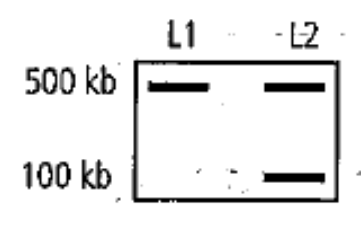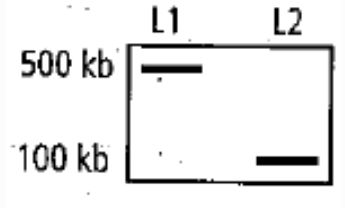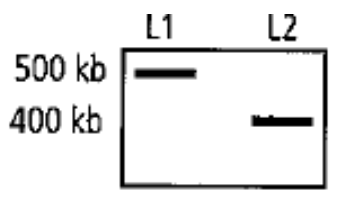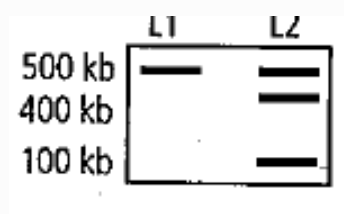The figure shows the restriction enzyme cutting sites (R1−R3) in wild type (n) and mutant (n) gene.

If a radioactively labelled probe (that hybridises at a sequence close to R1) is used for detecting the presence of DNA fragments after gel electrophoresis and Southern blotting, which of the following band patterns will yout expect ?
Note : L1 : wild type DNA, L2: mutant DNA Solution in Odia
(a) 
(b) 
(c) 
(d) 
The correct Answer is:C
Restriction enzymes recongise the base sequence of palindrome sites in DNA duplex and cut is strands. After the cutting of DNA by restriction enzymes, fragments of DNA are formed. Separation of DNA fragments according to their size is done by gel electrophoresis. since the probe hybridises close to R1 it will give 500 kb band for L1 and 400 kb band for L2 after gel electrophoresis.
Similar Questions
Arrange the various steps of DNA fingerprinting technique in the correct order.
(i) Separation of DNA fragments by electrophoresis.
(ii) Digestion of DNA by restriction endonucleases.
(iii) Hybridisation using labelled VNTR prode.
(iv) Isolation of DNA .
Detection of hybridised DNA fragments by auto-radiography.
(vi) Transferring the separated DNA fragments to nitrocellulose membrane.
View SolutionThe conversion of mutant type into wild type is called
View SolutionWrite the enzyme of DNA bases that the restriction endonuclease EcoRI recognizes. Identify the site at which this enzyme makes a cut in the DNA fragment?
View SolutionType-II Restriction enzymes cleave DNA fragments at which site
View SolutionFollowing are the steps of southern blot procedure. I. Autoradiography II. Hybridization with radioactive nucleic acid (probe) III. Blotting IV. DNA fragments are treated to make them single stranded V. Electrophoresis VI. Clearing of DNA by restriction endonuclease VII. Isolation of DNA from sample The correct sequence is-
View SolutionThe conversion of mutant type into wild type is called
View SolutionThe conversion of mutant type into wild type is called
View SolutionSelect the correct sequences of steps in DNA finger printing involving Southern blot hybridisation using radiolabelled VNTR as probe.
1 Hybridisation using labelled VNTR probe.
II. Isolation of DNA.
III. Transferring (blotting) of separated DNA fragments to synthetic membranes, such as nitrocellulose or nylon.
IV. Detection of hybridisation DNA fragments by autoradiography.
V. Separation of DNA fragments by electrophoresis.
VI. Digestion of DNA by restriction endonucleases.
View Solution